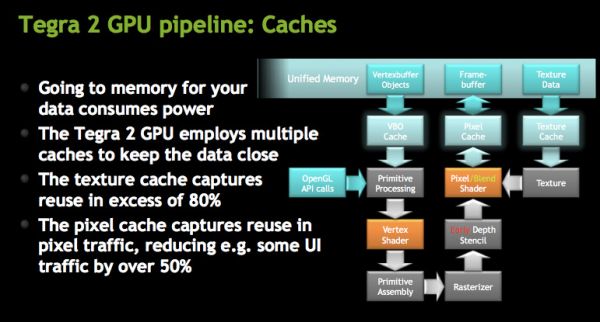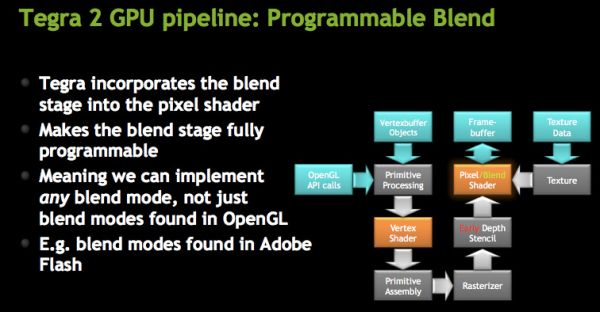LG Optimus 2X & NVIDIA Tegra 2 Review: The First Dual-Core Smartphone
by Brian Klug & Anand Lal Shimpi on February 7, 2011 3:53 AM EST- Posted in
- Smartphones
- Tegra 2
- LG
- Optimus 2X
- Mobile
- NVIDIA
The GeForce ULV
Complementing the three major CPU architectures in the mobile applications processor market for 2011 there are three major GPUs you’ll see crop up in devices this year: Imagination Technologies’ PowerVR SGX Series5 and Series5XT, Qualcomm’s Adreno 205/220 and NVIDIA’s GeForce ULV. There are other players but these three are the ones that will show up in the most exciting devices this year.
ImgTec licenses its GPUs for use in a number of SoCs. Apple’s A4, TI’s OMAP 3 and 4 and Samsung’s Hummingbird all use ImgTec GPUs. The currently used high end from ImgTec is the PowerVR SGX 540, which features four unified shader pipelines capable of handling both pixel and vertex shader operations. The PowerVR SGX 543 is widely expected to be used in Apple’s 5th generation SoC.
The PowerVR SGX as well as Qualcomm’s Adreno GPUs both implement tile based deferred rendering architectures. In the early days of the PC GPU race deferred renderers were quite competitive. As geometry complexity in games increased, ATI and NVIDIA’s immediate mode rendering + hidden surface removal proved to be the better option. Given the lack of serious 3D gaming, much less geometry heavy titles on smartphones today the tile based approach makes a lot of sense. Tile based renderers conserve both power and memory bandwidth, two things that are in very short supply on smartphones. Remember from our CPU discussions that in many cases only a single 32-bit LPDDR2 memory channel has to feed two CPU cores as well as the GPU. By comparison, even PCs from 10 years ago had a 64-bit memory bus just for the CPU and a 128-bit memory bus for the GPU.
NVIDIA believes that the future of GPUs on smartphones is no different than the future of PC GPUs: immediate mode renderers. As a result, the GeForce ULV GPU in NVIDIA’s Tegra 2 looks very similar to a desktop GPU—just a lot smaller, and a lot lower power. It’s also worth pointing out that until we get PC-like content on smartphones, NVIDIA’s approach to ultra mobile GPU architectures may not always make the most sense for power efficiency.
(Note that some of what follows below is borrowed from our earlier coverage of NVIDIA's Tegra 2):
At a high level NVIDIA is calling the GeForce ULV an 8-core GPU, however its not a unified shader GPU. Each core is an ALU but half of them are used for vertex shaders and the other half are for pixel shaders. You can expect the GeForce ULV line to take a similar evolutionary path to desktop GeForce in the future (meaning it’ll eventually be a unified shader architecture).

The four vertex shader cores/ALUs can do a total of 4 MADDs per clock, the same is true for the four pixel shader ALUs (4 MADDs per clock).
The GeForce ULV in NVIDIA’s Tegra 2 runs at a minimum of 100MHz but it can scale up to 400MHz depending on the SoC version:
| NVIDIA Tegra 2 | ||||||
| SoC | Part Number | CPU Clock | GPU Clock | Availability | ||
| NVIDIA Tegra 2 | T20 | 1GHz | 333MHz | Now | ||
| NVIDIA Tegra 2 | AP20H | 1GHz | 300MHz | Now | ||
| NVIDIA Tegra 2 3D | T25 | 1.2GHz | 400MHz | Q2 2011 | ||
| NVIDIA Tegra 2 3D | AP25 | 1.2GHz | 400MHz | Q2 2011 | ||
The AP20H runs at up to 300MHz, while the tablet version runs at a faster 333MHz.
Architecturally, the GeForce ULV borrows several technologies that only recently debuted on desktop GPUs. GeForce ULV has a pixel cache, a feature that wasn’t introduced in GeForce on the desktop until Fermi. This is purely an efficiency play as saving any trips to main memory reduces power consumption considerably (firing up external interfaces always burns watts quicker than having data on die).

NVIDIA also moved the register files closer to the math units, again in the pursuit of low power consumption. GeForce ULV is also extremely clock gated although it’s not something we’re able to quantify.
NVIDIA did reduce the number of pipeline stages compared to its desktop GPUs by a factor of 2.5 to keep power consumption down.
The GeForce ULV supports Early Z culling, a feature first introduced on the desktop with G80. While G80 could throw away around 64 pixels per clock, early Z on GeForce ULV can throw away 4 pixels per clock. While early Z isn’t the equivalent of a tile based renderer, it can close the efficiency gap between immediate mode renderers and TBRs.

The ROPs are integrated into the pixel shader, making what NVIDIA calls a programmable blend unit. GeForce ULV uses the same ALUs for ROPs as it does for pixel shaders. This hardware reuse saves die size although it adds control complexity to the design. The hardware can perform one texture fetch and one ROP operation per clock.
While GeForce ULV supports texture compression, it doesn’t support frame buffer compression.
Both AA and AF are supported by GeForce ULV. NVIDIA supports 5X coverage sample AA (same CSAA as we have on the desktop) and up to 16X anisotropic filtering.
The performance comparison is far more difficult to quantify in the ultra mobile space than among desktop GPUs. There are some very good 3D games out for Android and iOS, unfortunately none of them have built in benchmarks. There are even those that would make for good performance tests however OEM agreements and politics prevent them from being used as such. At the other end of the spectrum we have a lot of absolutely horrible 3D benchmarks, or games with benchmarks that aren’t representative of current or future game performance. In between the two extremes we have some benchmark suites (e.g. GLBenchmark) that aren’t representative of current or future GPU performance, but they also aren’t completely useless. Unfortunately today we’ll have to rely on a mixture of all of these to paint a picture of how NVIDIA’s GeForce ULV stacks up to the competition.
Just as is the case in the PC GPU space, game and driver optimizations play as large of a role in performance as the GPU architecture itself. NVIDIA believes that its experience with game developers will ultimately give it the edge in the performance race. It’s far too early to tell as most of NVIDIA’s partners aren’t even playing in the smartphone space yet. However if PC and console titles make their way to smartphones, NVIDIA’s experience and developer relationships may prove to be a tremendous ally.










75 Comments
View All Comments
rpmrush - Monday, February 7, 2011 - link
Solid review, but please at least use spell check. I'm not a grammar or typo freak, but there were way too many simple typos that spell check wouldn't even let you get by with. At least have someone proof read it before you publish to the public.zowie - Tuesday, February 8, 2011 - link
who can create a new type battery, who will be the richest man in the worlduhuznaa - Tuesday, February 8, 2011 - link
Yeah, and until then those who manage to come up with some decent power management will be the richest...Seriously, every improvement on the battery front almost always just leads to devices drawing more power. It's somewhat ironic that last year's iPhone still leads the pack when it comes to battery life. Power management (that is: don't draw more power than absolutely necessary by throttling or shutting down components that aren't needed or aren't fully needed in a given moment) is hard and boring design work nobody seems to care for. And with devices and software getting replaced with the next iteration every few months this is even understandable, it's just not worth the effort, especially when nobody seems to care and benchmarks are so much more important to the crowd.
DanNeely - Tuesday, February 8, 2011 - link
How is is typically played back: Cropped, or vertically resampled?Wilco1 - Tuesday, February 8, 2011 - link
Tegra 3 has 4 1.5GHz Cortex-A9's according to a leaked slide.That was a great article! A few minor corrections: The ARM11 VFP is fully pipelined (so it can beat the A8 on FP performance). Like the A8, Scorpion is 2-way in-order, not limited out-of-order. In-order cores issue instructions in-order but may complete them out-of-order. On the other hand, OoO cores use register renaming to issue instructions out-of-order but complete them in-order.
Note none of the micro benchmarks used emits Neon instructions. JIT compilers don't have enough time to generate high quality code, let alone autovectorize! For proper benchmarking you will need to run native code compiled with a quality compiler (not GCC - it is still far behind the state of the art on ARM, especially Thumb-2).
metafor - Tuesday, February 8, 2011 - link
I would argue with that definition of OoO. A design does not need register renaming in order to issue any arbitrary instruction OoO. It's simply a trade-off of whether to centralize hazard tracking on register accesses or on retirement.PWRuser - Tuesday, February 8, 2011 - link
Excellent review. Please, in your future reviews don't stop including gems like this one:"Generally while browsing I can feel when Flash ads are really slowing a page down - the 2X almost never felt that way."
That's what matters! Including hands on observations along with a full volley of synthetic benchmarks.
This review comes as close as humanly possible to portraying a handset's ability to readers without the said readers trying it out.
Your attention to detail puts other reviews to shame. Keep up the good work.
sarge78 - Tuesday, February 8, 2011 - link
Don't forget about ST-Ericsson's U8500 A9. They could be a major player in 2011/2012 with potential design wins from Nokia and Sony Ericsson.warisz00r - Tuesday, February 8, 2011 - link
What equipments do you use to test the phone's audio quality with?phut- - Tuesday, February 8, 2011 - link
"NVIDIA tells us that the Tegra 2 SoC is fully capable of a faster capture rate for stills and that LG simply chose 2MP as its burst mode resolution. For comparison, other phones with burst modes capture at either 1 MP or VGA. That said, unfortunately for NVIDIA, a significant technological advantage is almost meaningless if no one takes advantage of it. It'll be interesting to see if the other Tegra 2 phones coming will enable full resolution burst capture. unfortunately for NVIDIA, a significant technological advantage is almost meaningless if no one takes advantage of it. It'll be interesting to see if the other Tegra 2 phones coming will enable full resolution burst capture. meaningless if no one takes advantage of it. It'll be interesting to see if the other Tegra 2 phones coming will enable full resolution burst capture."LG have probably made this decision based on the sensitivity of the invariably minuscule sensor they will have used. Having 6 frames of 12mp is pointless if they are 12 incomprehensible megapixels due to the lacklustre sensitivity of the pixels in their chosen part.
The kind of sensor you find delivering a meaningful burst in something like a 5D mk2 is enormous and power hungry, in comparison to an operating environment such as a phone.